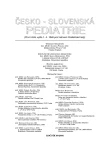-
Medical journals
- Career
Lowe Syndrome – Complex Diagnostics by Imaging Methods
Authors: J. Lisý 1; K. Bláhová 2; B. Petrák 3; V. Stará 2; J. Neuwirth 1
Authors‘ workplace: Klinika zobrazovacích metod 2. LF UK a FN Motol, Praha přednosta prof. MUDr. J. Neuwirth, CSc. 1; Pediatrická klinika 2. LF UK a FN Motol, Praha přednosta prof. MUDr. J. Vavřinec, CSc. 2; Klinika dětské neurologie 2. LF UK a FN Motol, Praha přednosta doc. MUDr. V. Komárek, CSc. 3
Published in: Čes-slov Pediat 2005; 60 (7): 419-423.
Category: Case Report
Overview
Oculocerebrorenal or Lowe syndrome is a hereditary gonosomal recessive disease caused by mutation of the OCRP gene on X chromosome. The ensuing deficit of inositol phosphatase results in the extracellular storage of lysosomal enzymes in the eyes, brain and kidney. It becomes manifest as a cataract, delayed psychomotor development with mental retardation. Renal tubular acidosis with proteinuria follows to compensatory decalcification of bones and hypophosphate rickets. Hypercalciuria results in nephrocalcinosis and nephrolithiasis.
The authors describe a broad spectrum of changes in a patient with Lowe syndrome using various imaging methods. The simple X-ray picture of the left hand and forearm in 6 months of age indicate rachitic changes, which disappeared after one year of treatment. Ultrasound of the abdomen demonstrated frequent calcifications on the corticomedullar border of both kidneys which correspond to nephrocalcinosis.
Ultrasonographic examination of the brain reveals gradual regression of a minute cyst in periventricular left frontal region within the framework of changes in periventricular leukomalacia (PVL), the finding being accompained by extension of the frontal horn of lateral ventricle.
Magnetic resonance (MR) of the brain in general anesthesia demonstrated diffuse tail-like foci in periventricular, but also subcortical localization, a light cortical atrophy and changes after the operation on ocular lenses for cataract.
The present case report substantiates the necessity of complex diagnostic approach with a wide spectrum of imaging methods in patients with disorder of the function of the kidney and bones.Key words:
Lowe syndrome, MR of the brain, nephrocalcinosis, rickets
Labels
Neonatology Paediatrics General practitioner for children and adolescents
Article was published inCzech-Slovak Pediatrics

2005 Issue 7-
All articles in this issue
- Occurrence and Fate of Fetuses with Hypoplastic Left Heart in the Region of Morava and Silesia during 2002 and 2003
- Evaluation of Sonographic Parameters of Renal Circulation in Hypotrophic Newborns
- Abuse of Anabolic Steroids among Youth in Fitness Centers
- Urinary Tract Infection in Children
- Lowe Syndrome – Complex Diagnostics by Imaging Methods
- Transverse Testicular Ectopia
- Drugs Interaction in Children Review
- Czech-Slovak Pediatrics
- Journal archive
- Current issue
- Online only
- About the journal
Most read in this issue- Lowe Syndrome – Complex Diagnostics by Imaging Methods
- Occurrence and Fate of Fetuses with Hypoplastic Left Heart in the Region of Morava and Silesia during 2002 and 2003
- Abuse of Anabolic Steroids among Youth in Fitness Centers
- Evaluation of Sonographic Parameters of Renal Circulation in Hypotrophic Newborns
Login#ADS_BOTTOM_SCRIPTS#Forgotten passwordEnter the email address that you registered with. We will send you instructions on how to set a new password.
- Career

